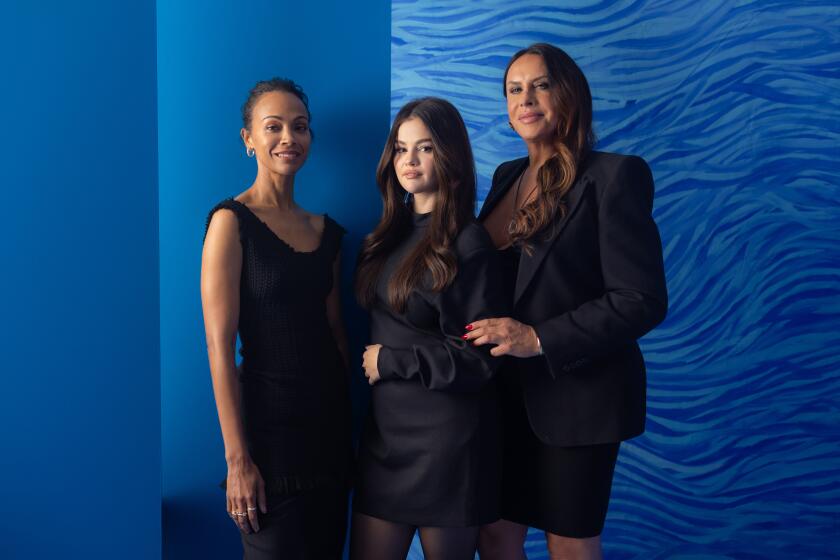Scorcese’s ‘Voyage’ to the Neo World
- Share via
Martin Scorsese’s superb, monumental “My Voyage to Italy” began in his parents’ Little Italy living room in the late ‘40s when his Sicilian immigrant family gathered around its new TV on Friday nights to watch Italian movies. He tells us that were it not for this weekly ritual, which started when Scorsese was 7 and already an avid moviegoer, he would have been “a very different person and a very different filmmaker.”
Suddenly, the little boy who loved Roy Rogers was confronted with the harsh realities of neo-realism, which had such an impact on his parents and grandparents and which also marked the beginning of his interest in his own roots. Drawing upon memories, snapshots and a home movie recently given to him by a cousin, Scorsese warmly evokes his own childhood. And he tells us how, through the Italian cinema, he discovered that a tumultuous history caused families--especially those as impoverished as his had been in the old country--to believe they could only trust each other.
Although Scorsese refers back to “Cabiria” (1914), the great historical spectacle that had a major influence on D.W. Griffith’s “Intolerance,” he concentrates on introducing us to the post-World War II cinema through the early ‘60s. Scorsese’s dedication to film preservation and passion for film history is well-known, but here he truly scales the heights. His unobtrusive, succinct narration of his inspired choice of films and of clips to represent them reveals him to be as masterful a film critic as he is a filmmaker.
From his highly personal perspective he provides consistently fresh and illuminating insights for viewers having their memories renewed by generous glimpses of one acknowledged masterpiece after another or who are being introduced to them for the first time. It hardly comes as a surprise that Scorsese’s grasp of human nature, history and cinema are never less than profound, and it is imperative that his narration for this film be published in book form. A four-hour, six-minute running time (not including an intermission) can be wearying, but “My Voyage to Italy” is consistently enthralling.
Scorsese felicitously describes neo-realism as the juncture of history and art, born of a dire economic necessity that precluded the expensive conventions of commercial filmmaking and a need for Italian filmmakers to regain the honor and dignity of their battered nation through an honest depiction of its wartime ordeal and defeat. Documentary and fiction were conflated, as Roberto Rossellini started filming his landmark “Open City” while deadly skirmishes were still going on in Rome. Scorsese makes the case that Rossellini is as important to world cinema as Griffith and states rightly that his influence endures and can be seen in the flowering of the Iranian cinema, to cite but one example.
Scorsese pays special attention to the films Rossellini made with Ingrid Bergman that began in scandal with their romance and her pregnancy while still married to her first husband and ended in their divorce in the wake of their poor critical and commercial success. Scorsese redeems “Stromboli” from Howard Hughes’ moralistic ending to show us how Rossellini meant for it to conclude with the spiritual awakening of its heroine, a Lithuanian refugee trapped in a marriage of convenience to a virile but uncomprehending fisherman.
Vittorio De Sica was Italy’s Cary Grant in the 1930s but, after the war, astounded the cinema world with “The Bicycle Thief,” which Scorsese quotes twice. He also places special emphasis on the less-known “Shoeshine,” which traces the horrors of war on children, and on “Umberto D,” in which an elderly retired bureaucrat finds it increasingly impossible for him and his beloved dog to survive on his meager pension.
Scorsese introduces us to Luchino Visconti, the Northern Italian nobleman-Marxist, via his neo-realist masterpiece “La Terra Trema,” revealing the economic exploitation of a fishing village, and then moves on to give major attention to “Senso” (1954), a sweeping romantic tragedy of love and betrayal set in Venice under Austrian occupation as the bloody struggle for a unified Italy unfolded. Scorsese demonstrates in detail how Visconti emerged as a masterful stylist of operatic temperament who evoked a “neo-realism of the past.”
Scorsese devotes the second half of his survey to the rise of Federico Fellini and Michelangelo Antonioni. He places more emphasis on Fellini’s “I Vitelloni,” that highly personal evocation of a group of 30-ish layabouts, emotionally immature and stifling in their seaside town (but lacking the courage to leave, and his even more autobiographical “81/2,” than his landmark “La Dolce Vita,” in which Marcello Mastroianni played a Roman tabloid columnist ensnared by the glittering milieu of pleasure-seekers he chronicles.
In bringing his ravishing survey to a close, Scorsese states simply that he wants to share his pleasure in experiencing films that he loves in the hope that it will contribute to keeping them alive. All film epochs in other cultures should be so lucky to receive such a celebration.
MPAA rating: PG-13, for some images of violence and sexuality. Times guidelines: Some scenes of wartime fighting, torture and abuse are too intense for children.
‘My Voyage to ItalyJW A Miramax Films release of a Mediatrade presentation in association with a Cappa production of a Mediatrade production in conjunction with Paso Doble films. Director Martin Scorsese. Producers Barbara De Fina, Giulana Del Punta, Bruno Restuccia. Executive producers Giorgio Armani, Riccardo Tozzi. Editor Thelma Schoonmaker. Running time: 4 hours, 6 minutes.
Exclusively at the Music Hall, 9036 Wilshire Blvd., Beverly Hills, (310) 274-6860.
More to Read
Only good movies
Get the Indie Focus newsletter, Mark Olsen's weekly guide to the world of cinema.
You may occasionally receive promotional content from the Los Angeles Times.










